Mazda has released the first official information and photos for its all-new Mazda6 sedan. Curiously, the model will make its debut this week at the Moscow Motor Show.
While teaser photos have been issued previously by Mazda, this is the first time we’ve been given a look at the car in full detail. Based on the ‘Kodo’ design language of the stylish Takeri concept, the translation from free reign to production reality has seen some casualties.
At the front we like the detailing of the grille and the sharp crease line over the wheel arch, which defines the Mazda6, setting it apart from its competition. However, the rear flank and tail lights have been toned down too much, we think. To the point that their rounded edges almost look mismatched compared to the higher drama seen up front.
Overall, though, the new Mazda6 is a fine looking car and we’re sure it will create plenty of sales for an already healthy Mazda Australia.
The interior has seen the biggest change from the concept, which is probably to be expected. However, from the photos we see here, it looks as though Mazda has delivered a well laid out set of controls in a smart manner. We don’t think the interior will approach Volkswagen/Audi levels of refinement, but we also don’t expect it to be disappointment.
You’ll need to start getting used to a new marketing buzzword. Skyactiv and i-stop return from earlier models, but we now must add i-eloop for the brake regeneration system featured in the Mazda6.
Mazda6 programme manager, Hiroshi Kajiyama, declares driving dynamics were at the forefront of their mind while creating the car. “In developing the third-generation Mazda6, we pursued Mazda’s intrinsic core value: ‘driving pleasure’,” he said.
“We wanted to create a car that reacts and behaves exactly as you expect it to. Part of this involved carefully crafting those parts of the car which you often touch to feel as though they are an extension of your own body.
“The distinctive exterior design hints at the power and agility with which the car moves. A variety of original innovations support a comfortable and enjoyable driving experience. Mazda’s superb engineering and craftsmanship have created a car that handles so well it seems to respond directly to the driver’s intentions rather than the physical manipulations of steering, braking and accelerating.”
More pics and a comprehensive press release from Mazda can be read below. It’s worth noting at this stage that all specifications listed here relate to the Russian market. Mazda is keen to point out that European, and we expect Australian, specs will differ. Having said that we can’t say we’re expecting any massive changes from what you’ll read below.
All-New Mazda6 Saloon
New flagship model adds a fresh dimension to the ‘Celebration of Driving’
The all-new Mazda6, which celebrates its world premiere at the 2012 Moscow Motor Show, is the second of a new generation of Mazda vehicles which adopt the Japanese company’s full range of SKYACTIV technology and the ‘KODO – Soul of Motion’ design language. Mazda has consistently strived to provide stylish, insightful and spirited cars and the new generation vehicles – the CX-5 compact SUV and new Mazda6 flagship model – deliver a high-quality, exhilarating driving experience, while offering outstanding environmental and safety performance.
Mazda’s environmental technology development is directed by its Building Block Strategy which first calls for thorough improvements in already well established automotive technologies. The next step builds on these improvements with the sequential introduction of electric devices designed to improve fuel economy.
The first such device was the i-stop idling stop system introduced in 2009 with the Mazda3. The second device, which makes its first appearance on new Mazda6, is i-ELOOP – Mazda’s unique brake energy regeneration system that begins charging a capacitor the moment the driver takes his foot off the accelerator.
Electricity stored in the capacitor can then be used to power electric components throughout the car. In freeing the engine from much of the duty of providing electricity to these components, more fuel energy goes directly to powering the car, resulting in further improvements in fuel economy. In addition, a variety of advanced active safety technologies have been adopted for new Mazda6.
Drawing on the full potential of both SKYACTIV technology and KODO design, the new Mazda6 aims to take the “joy of driving†to a new level. As the flagship model of a new generation of vehicles, it will build on the momentum created by the success of CX-5, and heralds a new era for the Mazda brand. New Mazda6 will be introduced to global markets starting in late 2012.
Flagship model powers driving pleasure to a higher level
“In developing the third-generation Mazda6, we pursued Mazda’s intrinsic core value: ‘driving pleasure’. We wanted to create a car that reacts and behaves exactly as you expect it to. Part of this involved carefully crafting those parts of the car which you often touch to feel as though they are an extension of your own body,†says Hiroshi Kajiyama, the new Mazda6 programme manager.
“The distinctive exterior design hints at the power and agility with which the car moves. A variety of original innovations support a comfortable and enjoyable driving experience. Mazda’s superb engineering and craftsmanship have created a car that handles so well it seems to respond directly to the driver’s intentions rather than the physical manipulations of steering, braking and accelerating.
“In short, the new Mazda6 offers the ‘joy of driving’ that people have come to expect from a Mazda, but now the experience starts even before you get behind the wheel and lingers long after the drive is over. I can’t wait to see the look on the faces of people getting out of the car after their first time behind the wheel of the new Mazda6,†adds Kajiyama.
Design
An exceptional presence creates an expectation of outstanding performance
New Mazda6 is the production model born of the Mazda Takeri concept car first showcased at the Tokyo Motor Show in December 2011. “The new Mazda6 has a robust framework and a low, wide stance that expresses strength and stability, creating the impression of amazing vitality, without detracting from the universal aesthetic appeal and beautiful form it displays as a C-D segment car,†says chief designer Akira Tamatani.
“We have created a design in which the wild and dynamic expressions of motion artistically realise a powerful presence. Simply looking at the car heightens one’s expectations about the driving experience even before actually riding in it.â€
At a single glance, the exterior design of the 4.8-metre long saloon conveys animal-like tenacity, dignity and a sporty flare through its smooth and powerful physique. The coordinated interior, in keynote black, is both chic and contemporary without compromising on a timeless feeling of luxury and quality.
Exterior
- At the front, the ‘signature wing’ is incorporated, a unifying element of the new Mazda family design, set into the deeply sculpted face. The hood creases extend from the tips of the signature wing and flow into the body character lines. Together with the solid design of the nose, they complement the overall dynamic form of the body that expresses a strong desire for motion.
- Three character lines dominate the side view – an elegant line that extends forward from the rear wheel, a rear fender line suggesting driving force from the vehicle’s hind quarters, and a front fender line denoting strong shoulders supporting nimble front feet. The combination of these lines captures the form of a predator crouched and ready to leap forward in an explosion of movement.
- The rear view displays stability through the well balanced proportions of the wedge-shape body, prominent rear fender and compact cabin.
- For the head lights, signature LED luminescence and halo ring light guides are adopted for the first time in a Mazda production vehicle.
- The first use of ‘Soul Red’ paint, a new colour born of a unique technological process developed by Mazda, that balances depth and shading which accentuate the car’s dynamic form, and vividness which expresses sportiness.
Interior
- The driver-oriented cockpit offers generous space. Three instruments laid out symmetrically beneath the meter hood heighten the expectation for exciting driving.
- The front passenger side space provides a sense of both openness and safety with the decorative horizontal line extending through the centre panel to the air-conditioning louvers.
- Soft materials are used for areas frequently touched by occupants, such as the door trims and the upper part of the dashboard panel.
- The decorative centre stack panel features two colors, ‘Bordeaux metal’ and ‘Dark metal’.
- White scale markings appear to stand out from the instrument gauge faces which feature a combination of spindle groove and honeycomb patterning to achieve a feeling of depth and quality craftsmanship. An encircling metal ring completes a tasteful design for each gauge which conveys a zeal for driving.
Craftsmanship
Quality that raises the anticipation of genuine ‘premium driving’
New generation Mazdas are developed under the design craftsmanship concept which incorporates the designer’s aesthetic sense into the very foundation of the vehicle’s detailed and precise engineering.
Full-scale implementation of this concept with the new Mazda6 enabled a high-grade, premium finish with a harmony of form and quality to be achieved, while not compromising on functionality. Attention was paid to areas that passengers see and touch, and also to the feel and sound of operating the vehicle, in order to create a sense of unity throughout the car.
An overall feeling of quality appeals to all the senses and creates an expectation that the new Mazda6 will offer heightened levels of premium driving pleasure no matter where you take it.
- Details of all parts, including design pattern, moulding profile, surface grain and gloss treatments are carefully executed according to a consistent philosophy.
- In the cabin, the dashboard and centre stack are laid out horizontally, and a smooth continuity between the upper area of the dashboard and the door trims creates an impression of simplicity and neatness.
- Care has been taken to add a subtle sparkle with metal-like decorations, such as satin chrome plating.
- Parts which the driver often handles, such as the steering wheel, gear shift knob and parking brake lever, are carefully crafted to achieve a smooth and consistent feel.
- The layout of all the switches and controls surrounding the driver’s seat has been optimised, while taking into consideration both the characteristics of human vision, arm and hand movements.
Packaging
Cabin design and ergonomics fill everyday with joy
A spacious and comfortable environment is provided within the new Mazda6 model’s dynamic and elegant body form created by KODO design. The cabin offers an environment where the driver can relax and concentrate on the pleasure of driving. A feeling of anticipation is stirred every time you look at the car, run your hand over the door handle, grasp the steering wheel or adjust the interior mirror.
Two fundamental aims directed the development of the interior packaging. The first was to realise a spacious, comfortable cabin that perfectly matches KODO design. The second was to refine the Human Machine Interface (HMI) to create a cockpit environment where the driver can feel completely at ease. The new Mazda6 features packaging that achieves these goals and provides driver and passengers with a great environment in which to relish the ‘joy of driving’.
Spacious, comfortable cabin that perfectly matches KODO design
- The 2,830mm long wheelbase (105mm longer than previous model) creates generous front and rear space and a broad canvas for the unrestrained expression of KODO.
- Large 19-inch diameter wheels create a feeling of unshakable stability.
- Compared to the previous model, the front wheel has been moved forward by 100mm in relation to the A-pillar resulting in reduced front overhang. The rear deck is also shorter than the previous model. The car’s stance, with the bulk of the mass toward the rear, gives a sense of explosive power ready to be unleashed at any moment.
- Shoulder room of 1,450mm in the front seat (20mm wider than previous model) and a large radius to the corners of the centre console, ensure comfortable seating.
- The rear seats feature ample legroom with a knee clearance 43mm greater than the previous model and amongst the best in class. Legroom is 984mm, 37mm more than the previous model. The length of the rear seat cushion is increased by 20mm and the seat back height by 33mm. The rear centre arm rest has been enlarged by 60mm.
- The trunk was designed from an ergonomic perspective. The upper opening width is 32mm wider than on the previous model, for easy loading. A swan-style hinge ensures easy and smooth opening and closing of the trunk.
Cockpit environment
- A fully adjustable front seat combined with adjustable tilt and telescopic steering wheel enable precise adjustment of the driving position.
- A multi commander allows intuitive control of an array of functions such as audio, navigation system and sensitivity of the automatic windshield wipers via the centre display.
- Trip management information is displayed on a 3.5-inch multi-information screen in the instrument cluster. Navigation information is shown on a 5.0-inch display located in the centre panel. By separating information into categories and showing them on two different displays, readability and operability were further enhanced.
Driving dynamics
Precise handling achieves impressive dynamic performance
When developing the driving dynamics of the new Mazda6, the chassis engineer’s aim was to provide an exhilarating driving experience that can only be felt when the driver and car become one – echoing the Jinba Ittai bonding of man and machine, first accomplished by the iconic Mazda MX-5 sportscar.
Mazda’s fundamental belief is that a smooth linear response to driver input is the basis of real driving pleasure, and full enjoyment cannot be attained through sheer speed and power alone. This was the motivation for the introduction of SKYACTIV technology throughout the new Mazda6 including the engine, transmission, body and chassis.
Aiming to achieve both agility and linearity by uniting the driver and the car, Mazda technicians concentrated on providing outstanding levels of high performance via a control system that responds to the driver’s intentions. In terms of acceleration characteristics, this means natural, linear acceleration in response to throttle pedal operation without a hint of delay or jerkiness.
For cornering characteristics, this philosophy demanded faithful responses to steering input, providing immediate feedback from the road and mildly increasing body roll so that no steering adjustment is required to maintain the desired cornering line.
Finally, for braking characteristics, the goal was braking performance that gives the driver the feeling of being in complete control, even when releasing the brakes. Closely concentrating on human sensitivity, Mazda’s development team balanced fundamentally contradictory characteristics of motion: refined, supple motion and light, agile motion.
Appropriately for the all-new Mazda flagship model, extremely impressive driving performance was achieved – including superior high-speed stability that gives the feeling of complete control – providing a truly enjoyable, comfortable drive regardless of distance.
Chassis & Body
- The all-new Mazda6 saloon has a finely tuned SKYACTIV-Chassis front MacPherson strut and rear multi-link suspension, delivering agile handling in the low-speed to mid-speed ranges and excellent stability in high-speed driving.
- The new column-type electric power assistance, the steering system offers precise control by responding to small steering inputs as needed without requiring changes in the positions of the driver’s hands on the wheel, thus contributing to a linear steering feel. The new type of assistance enhances straight-line stability and prevents steering pull when driving over rough road surfaces.
- The optimised brake booster characteristics deliver effective, precise and assured braking performance all the way up to the highest G-forces. This is the result of easily-controllable initial pedal application and enhanced stability enabled by increased brake cooling efficiency.
- The robust SKYACTIV-Body structure makes wider use of ultra-high tensile steel reducing weight, while at the same time improving torsional rigidity by about 30 percent.
- Engineering work on NVH performance focused on achieving class-leading quietness in the cabin and creating a pleasant yet exhilarating engine sound under acceleration. The improved NVH performance mainly comes from effectively blocking noise paths from the engine and the road surface to the cabin and designing parts to effectively absorb sound energy at source.
- The optimised under-floor design improves aerodynamic performance by smoothing the airflow under the vehicle and minimising the trailing vortex by directing the exiting airflow upwards via the tail-up design of the main exhaust silencer.
- The coefficient of drag is a class-leading Cd 0.26 (depending on grade). This contributes to high-speed stability as well as fuel efficiency.
Powertrain (specifications for gasoline engines being shown in Moscow)
SKYACTIV-G 2.0
Offers abundant torque at low engine speeds, contributing to a pleasant ride and superb fuel economy. Maximum torque is 210Nm / 4,000rpm and maximum output is 150ps at 6,000rpm.
SKYACTIV-G 2.5
Is a new engine making its first appearance in the new Mazda6. This lightweight unit delivers maximum torque of 256Nm / 3,250rpm, with 192ps at 5,700rpm.
Environment and Safety
Maximised safety protection for complete peace of mind
The environmental and safety performance of new Mazda6 is enhanced so customers can enjoy driving with complete peace of mind.
In terms of environmental performance, the addition of i-stop and i-ELOOP improves the already outstanding fuel economy achieved with SKYACTIV technology. The foundation of the new Mazda6’s safety performance lies in its outstanding handling that responds immediately to the driver’s inputs, the excellent visibility it provides and the crash-worthiness of the highly robust SKYACTIV-Body.
In addition, an array of advanced safety technologies has been employed to support the driver in the safe operation of the vehicle. For example, Rear Vehicle Monitoring (RVM) and Adaptive Front Lighting (AFS) are available, together with Smart City Brake Support (SCBS), which made its debut on CX-5. Finally, superior passive safety minimises damage and injuries if a collision occurs.
Environmental performance
- The new Mazda6 is the first model to adopt the ‘i-ELOOP’ brake energy regeneration system, which contributes to an improvement in fuel efficiency in real world driving situations. This is the first passenger car brake energy regeneration system in the world to utilise a capacitor. SKYACTIV-G 2.5 models are equipped with i-ELOOP.
- Mazda’s original idling stop system, ‘i-stop’, first used on Mazda3, is introduced to the new Mazda6. This system boasts a class-leading engine re-start time of just 0.35 seconds.
- Award-winning single-nanotechnology in the catalyst improves the exhaust gas after-treatment process and reduces the amount of precious metal required.
Safety performance
Active Safety Technologies
Maximising the range of conditions in which the driver can drive safely and comfortably
- Moving the bottom of the A-pillar rearwards by 100mm, compared with the outgoing model, and mounting the rear view mirror on the door rather than the base of the A-pillar helps to enhance both the forward and peripheral visibility.
- High-Beam Control system (HBC) uses a sensor to detect oncoming vehicles and automatically changes between high and low beam to help avoid dazzling other drivers during night driving.
- Adaptive Front-lighting system (AFS) predicts curves based on the degree of steering input and vehicle speed and turns the headlights in the direction that the vehicle is heading – improving visibility when driving at night.
- Hill Launch Assist (HLA) helps prevent the Mazda6 from rolling backwards while the driver’s foot moves from the brake pedal to the accelerator pedal when moving off on an incline.
Providing hazard alerts to help the driver avoid dangers and regain safe control of the vehicle
- Emergency Stop Signal (ESS) cause the hazard lights to rapidly flash on and off in the event of panic braking at 50km/h or faster, in order to warn vehicles behind.
- Rear Vehicle Monitoring (RVM) comes into effect at speeds above 30km/h and detects cars approaching from behind or driving in the blind spot on either side, warning the driver when he turns on the indicator to change lanes.
- Lane Departure Warning System (LDWS) uses a forward-facing camera to judge the position of lines on the road and warns the driver of unintentional lane departures, thus minimising the risk of collision due to driver inattention or fatigue.
Helping avoid or reduce the severity of a collision
- Smart City Brake Support (SCBS) uses a near-infrared beam sensor to monitor the distance to the vehicle ahead and prevent or greatly reduce the severity of frontal collisions at low speeds (up to 30km/h) by automatically applying the vehicle’s brakes. It is standard-fit on all CX-5 models in the UK.
Passive Safety Technologies
Helping protect passengers and pedestrians in the event of a collision
- The lightweight yet highly-rigid SKYACTIV-Body provides excellent crashworthiness and is designed to attain top safety ratings in official crash tests around the world.
- A multi-load path structure and a front end with an X-shaped cross-section increases impact energy absorption, further improving safety performance in frontal, side and rear-end collisions.
- The anti-whiplash design of the front seats helps to reduce neck injury in the event of a rear-end collision.
- There are two impact beams in the front doors. The upper beam has a round cross-section, and the lower beam has a double-ridged cross-section. The lower rear door beam also has a double-ridged cross-section, helping to improve strength.
Technical Specifications (Preliminary Data)
Dimensions
Body type: Saloon
Doors: 4
Seating capacity: 5
Coefficient of drag*: 0.26
Overall length: mm 4,865
Overall width: mm 1,840
Overall height: mm 1,450
Wheelbase: mm 2,830
Track Front: mm 1,585 (17-inch wheel), 1,595 (19-inch wheel)
Track Rear: mm 1,575 (17-inch wheel), 1,585 (19-inch wheel)
Cargo volume: Litres 483
Load floor length to 1st row: mm 1,961
Load floor length to 2nd row: mm 1,190
*depending on grade, wheel and tyre size
Engines*
SKYACTIV-G 2.0
Capacity cc: 1,998
Valves: 16
Cam-drive: Chain
Fuel system: Direct injection
Compression: 14.0:1
Max. power kW/ps: 110 / 150 at 6,000
Max. torque Nm: 210 at 4,000
Fuel: Above 95RON
Tank capacity L: 62
Powertrain: FWD
Transmission: SKYACTIV-D (6-speed automatic), SKYACTIV-MT (6-speed manual)
Petrol SKYACTIV-G 2.5 Petrol
Capacity: 2,488
Valves: 16
Cam-drive: Chain
Fuel system: Direct injection
Compression: 13.0:1
Max. power kW/ps: 141 / 192 at 5,700
Max. torque Nm: 256 at 3,250
Fuel: Above 95RON
Tank capacity L: 62
Powertrain: FWD
Transmission: SKYACTIV-D (6-speed automatic)
* These are Russian market specifications only and do not apply to Europe.
Chassis
Front suspension: MacPherson Strut
Rear suspension: Multilink
Tyre size: 225 / 55 R17, 225 / 45 R19
Wheel size: 17 x 7.5J, 17 x 7.0J, 19 x 7.5J
Steering type: Power-assisted rack and pinion
Brake type: Ventilated discs (front) / Solid discs (rear)
Brake Diameter mm: 297 (front) / 278 (rear)
Performance and Weights (Target data)*
SKYACTIV-G 2.0 Petrol
Consumption l/100km (combined): MT 6.0, AT 6.1
CO2 g/km2: MT 140, AT 144
Kerb weight kg: MT 1,340, AT 1,370
Emissions: Euro 4
SKYACTIV-G 2.0 Petrol i-stop
Consumption l/100km (combined): AT 5.9
CO2 g/km2: 139
Kerb weight kg: 1,380
Emissions: Euro 4
SKYACTIV-G 2.5 Petrol i-ELOOP, i-stop
Consumption l/100km (combined): AT 6.4
CO2 g/km2: 151
Kerb weight kg: 1,410
Emissions: Euro 4
* These are Russian market specifications only and do not apply to Europe.
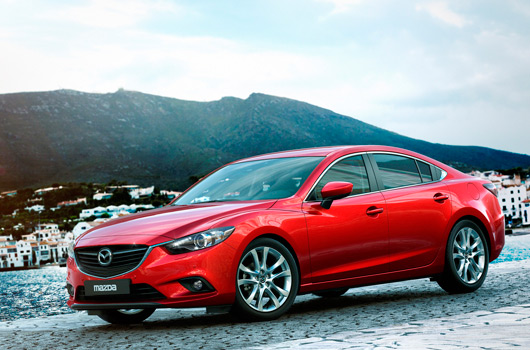
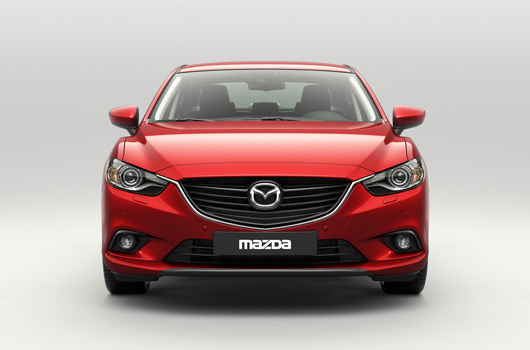
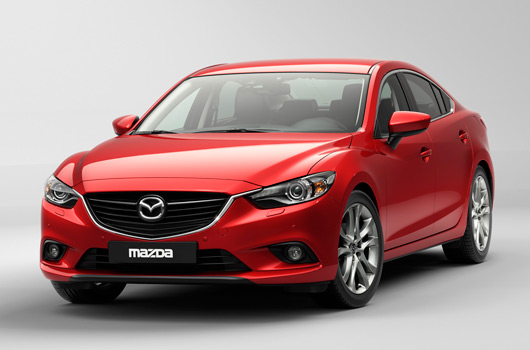
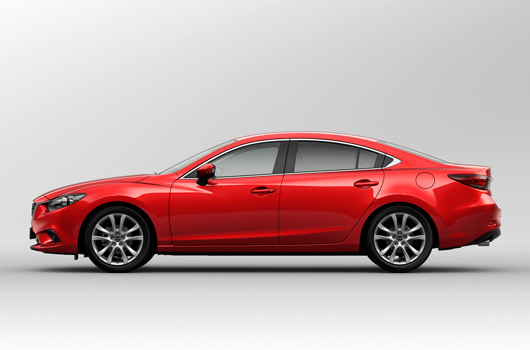
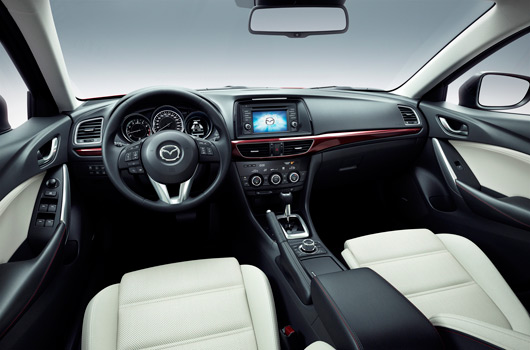
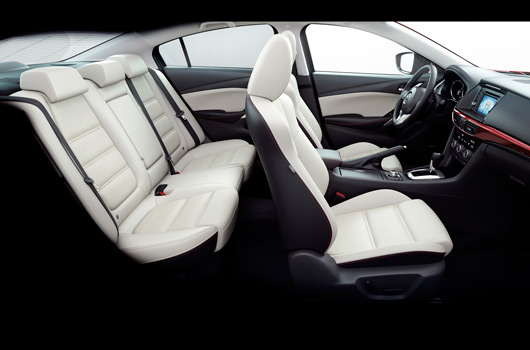
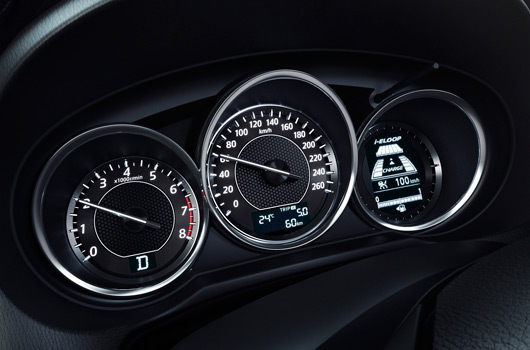
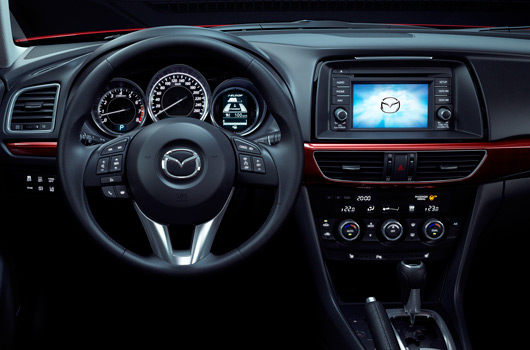
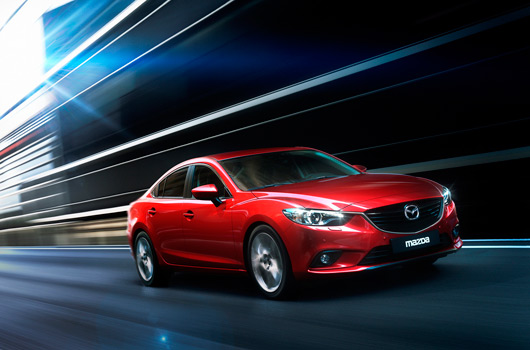
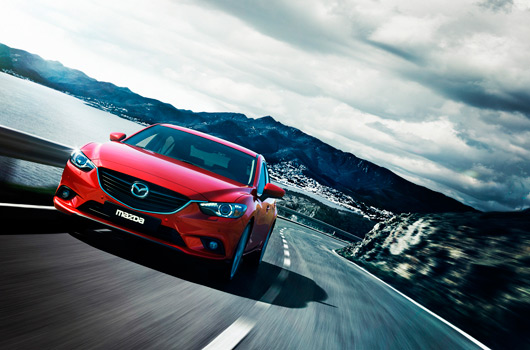
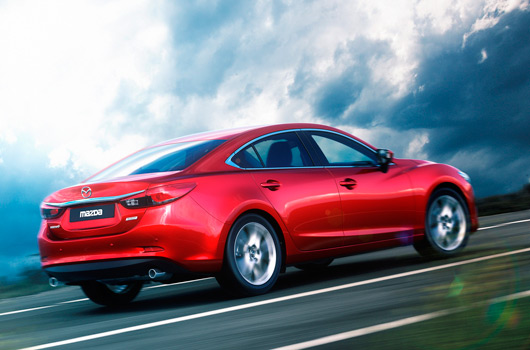
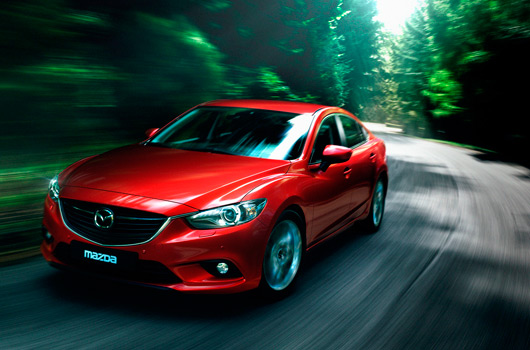
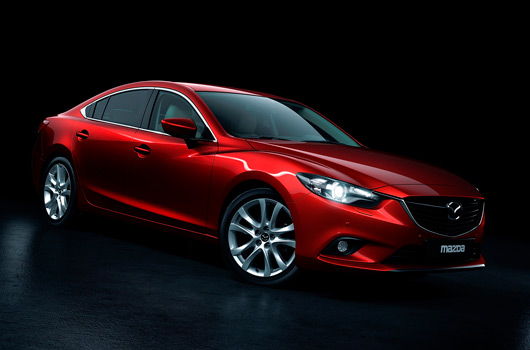
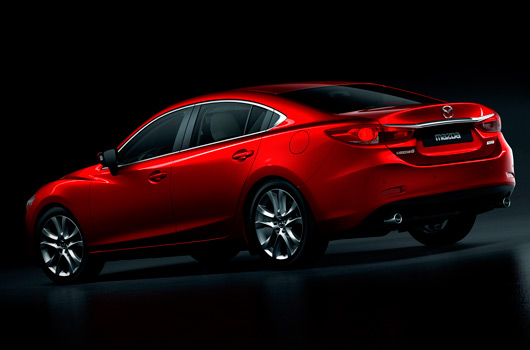
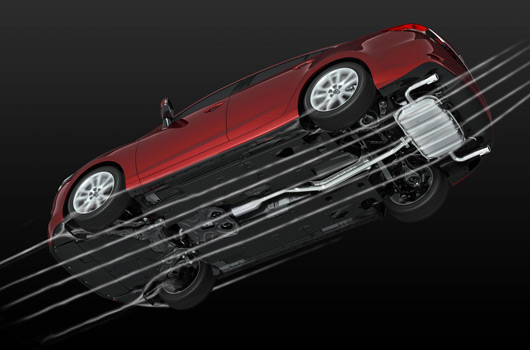
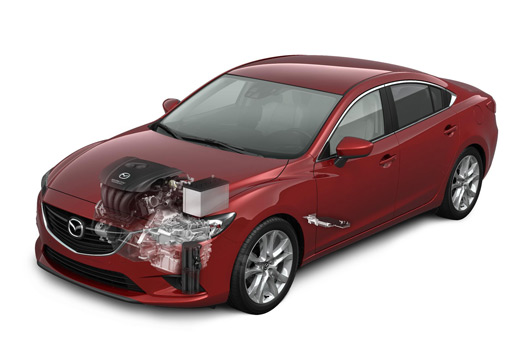
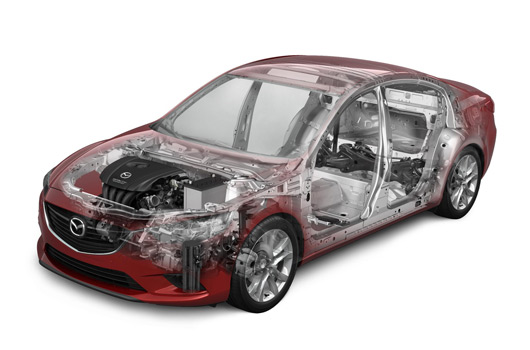
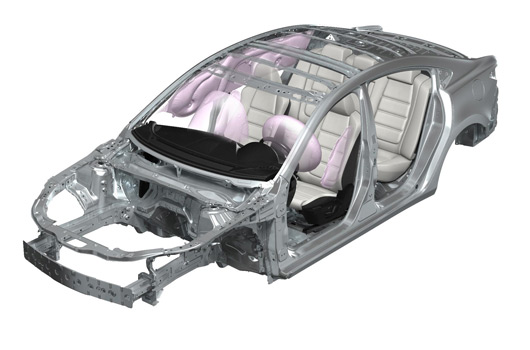
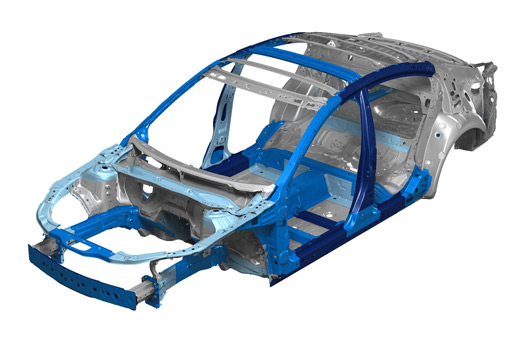
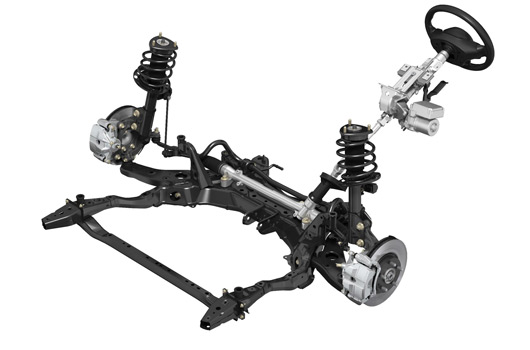
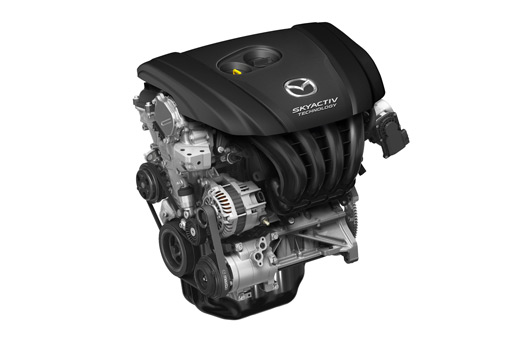
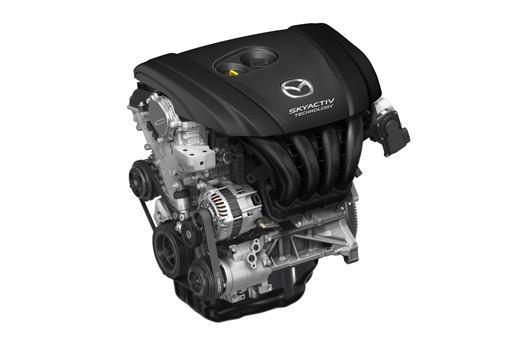
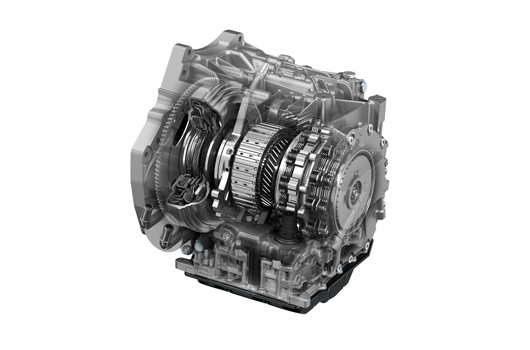
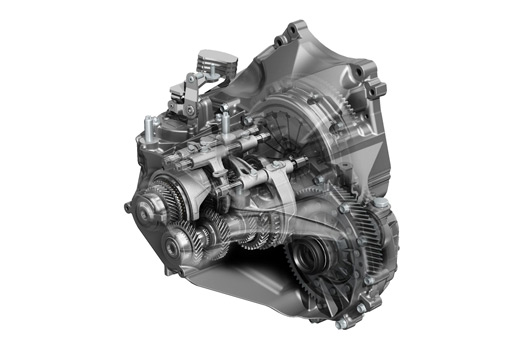
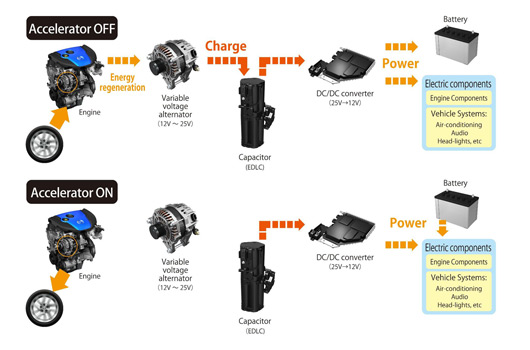
13 replies on “2013 Mazda6 revealed”
Good to see Mazda back to making nice looking cars. Don’t suppose they’ll make an MPS version though :(.
There is talk that they might, and a coupe version as well. I’ll have something up regarding those rumours later today with any luck.
Thanks Liam! That is a HUGE rumour for me to hear. I’d heard about the possibility of the coupe [4-door coupe shape?], but an MPS version would be most excellent.
[…] Some tasty and rather spicy news has emerged from the Russian debut of the all-new Mazda6 saloon. […]
[…] Last week Mazda gave us a preview of its new Mazda6 wagon before it makes its debut in Paris. Of course, it’s the practical twin to the stylish new Mazda6 sedan. […]
[…] Mazda 6 […]
[…] weapon of choice? A diesel-powered Mazda6. We imagine panel beaters around Melbourne will be pleased for the practice they will be given on […]
[…] Over the next little while you’ll be hearing a lot about Mazda’s new Skyactiv i-ELOOP technology. In Australia our first look at this new tech will be in the 2013 Mazda6. […]
[…] Australia is enjoying a bumper 2012, and word that their new Mazda6 will be on sale down under ahead of schedule in early December can only improve their already […]
[…] has already achieved a new sales record this year. And we think the arrival of the stylish new Mazda6 in local showrooms will further send the brand’s sales tally into […]
[…] Australia says 1531 Australian delivered new Mazda6 models are affected by a recall which numbers 15,000 vehicles […]
[…] The design experts formed a shortlist that was passed on to the World Car jurors to choose from. Joining the F-Type in the fight for votes were the Aston Martin Vanquish and the Mazda6. […]
[…] the third-generation Mazda3 draws heavily on the stylish Kodo design language on which the larger Mazda6 is based. The low front-end flows smoothly to a rear-end that we think Subaru probably wished […]